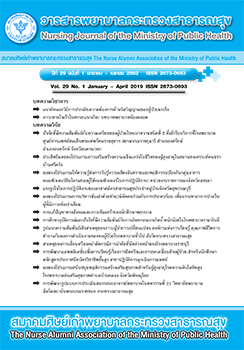Causal Relationship Model of Transformational Leadership, Learning Organization and Quality of Work Life Influencing Patient Unit Performance in General Hospitals under the Ministry of Public Health
Main Article Content
Abstract
The purposes of this correlational research were to identify and test a causal relationship model of transformational leadership learning organization, quality of work life and patient unit performance. The multi-stage sampling technique was used to include 386 nurses at eighty-three general hospitals under the Ministry of Public Health, Thailand. They were asked to answer five sets of questionnaires: 1) Personal Data Form, 2) Transformational Leadership Questionnaire, 3) Learning Organization Questionnaire, 4) Quality of Work Life Questionnaire, and 5) Patient Unit Performance Questionnaire. The reliability of each questionnaire had a Cronbach’s alpha Coefficient of .98, .98, .97 and .91, respectively. Data were analyzed using the statistical data analysis program for Structural Equation Modeling: SEM.
The findings of this study revealed patient unit performance was at the high level (=3.61, SD=.41). Transformational leadership of head nurse had positive direct effects on learning organization and quality of work life (ß=.59, ß=.55 p<.001), respectively. Transformational leadership of the head nurse also had an indirect effect on patient unit performance through learning organization (ß=.09, p<.001), it also had an indirect effect on patient unit performance through quality of work life (ß=.35, p<.001). Learning organization had positive direct effects on patient unit performance (ß=.16, p<.001), and quality of work life had positive direct effects on patient unit performance (ß=.64, p<.001). The model accounted for 59 % of the variance in Patient Unit Performance and a substantial proportion of the variance of the mediating variables.
Article Details
บทความและรายงานวิจัยในวารสารพยาบาลกระทรวงสาธารณสุข เป็นความคิดเห็นของ ผู้เขียน มิใช่ของคณะผู้จัดทำ และมิใช่ความรับผิดชอบของสมาคมศิษย์เก่าพยาบาลกระทรวงสาธารณสุข ซึ่งสามารถนำไปอ้างอิงได้
References
2. Abdullah MMB, Tarí JJ. The influence of soft and hard quality management practices on performance. Asia Pacific Management Review. 2012;17(2):177-93.
3. Clarke S. Research on nurse staffing and its outcomes: the challenges and risks of grasping at shadows. In: Nelson S, Gordon S, editors. The complexities of care: nursing reconsidered. Ithaca, NY: Cornell University Press; 2006; 161–84.
4. Kieu HQ. Leadership styles and organizational performance: a predictive analysis: University of Phoenix; 2010.
5. Waisayarat, S. “A casual model of organizational performance in energy sector: stock exchange of Thailand Committee [Dissertation]. Nakornpathom: Christian University of Thailand; 2010. (in Thai)
6. Shahbazi B, Shokrzadeh S, Bejani H, Malekinia E, Ghoroneh D. A survey of relationship between the quality of work life and performance of Department Chairpersons of Esfahan University and Esfahan Medical Science University. Procedia-Social and Behavioral Sciences. 2011;30:1555-60.
7. Silins HC, Mulford WR, Zarins S. Organizational learning and school change. Educational Administration Quarterly. 2002;38(5):613-42.
8 .Chinachot, P. Causal relationships between factors influencing the quality of work life of Commercial Bank personnel in Thailand. [Dissertation]. Bangkok: Ramkhamhaeng University of Thailand; 2014. (in Thai)
9. Rethinam GS, Ismail M. Constructs of quality of work life: a perspective of information technology professionals. European Journal of Social Sciences. 2008;7(1):58-70.
10. Senge P. The art and practice of the learning organization: the fifth discipline. Double Day: New York; 1990.
11. Song JH. The integrative determinants of organizational performance improvement: the impacts of dimensions of learning organization and dynamic knowledge creation: The Pennsylvania State University; 2008.
12. Bass BM, Avolio BJ. Transformational leadership development: manual for the multifactor leadership questionnaire: Consulting Psychologists Press; 1990.
13. Walton RE. Criteria for quality of work life. In: Davis, L.E.Cherns, R.L.eds. The quality of working life: problems, prospects. New York: the State of the Art ArtFree Press; 1974.
14. Baldrige National Quality Program. Health care criteria for performance excellence. 2009-2010 [cited 2014 Sep 21]. Available from: https://books.google.co.th/books?id=M0SdUlMLBgwC&printsec=frontcover&hl=th&source=gbs_ge_summary_r#v=onepage&q&f=false
15. Hair JF, Black WC, Babin BJ, Anderson RE, Tatham RL. Multivariate data analysis: New Jersy: Prentice Hall; 2010.
16. Sinjaru,T. Research and statistical data analysis with SPSS. Bangkok: V. Inter print; 2007. (in Thai)
